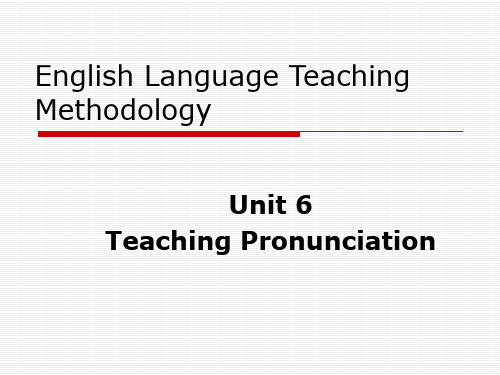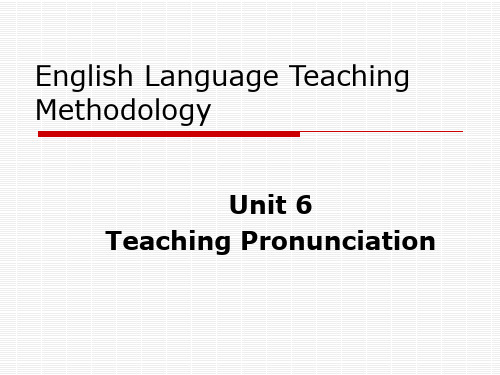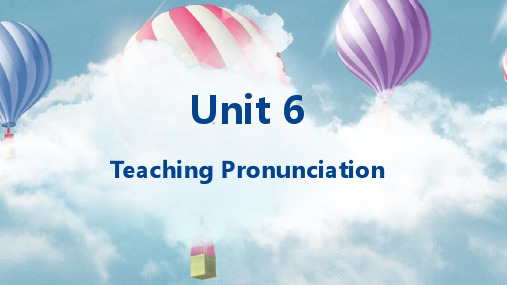英语专业院校的原版课件--英语教学论Unit 6 Teaching Pronunciation
合集下载
英语教学法教程课件06

10.Bad intonation can lead to serious misunderstandings.
Distinction between pronunciation and phonetics
Phonetic rules should be avoided at the beginning stage
well well S
well
will
D
bit lid back load
pit lid bag load
(No. 4 is different.) (No. 2 is different.) (No. 3 is different.) (No. 2 is different.)
Completion
a meaningful word or phrase or sentence. Students generally pick up the sound system by listening to your model or voices on cassette, etc.
If we spend a lot of time on pronunciation exercises, student interest may dwindle. So, teachers should move on to something else when pronunciation exercises no longer produce noticeable progress. Five to ten minutes of class time per meeting for as long as the need and willingness of the students last — this is a golden rule. (Bowen, 1985).
《英语教学法》Unit 6 Teaching Pronunciation

4. Practices of teaching English pronunciation
4.பைடு நூலகம் Practising sounds
Focusing on a sound
Imagine that you want to focus on a sound which your students are having difficulty with. How will you do it?
( ) __ Get the students to repeat the sound in chorus. ( ) __ Explain how to make the sound.
( ) __ Contrast it with other sounds.
( ) __ Write words on the blackboard. ( ) __ Get individual students to repeat the sound. ( ) __ Say the sound in a word. ( ) __ Say the sound alone. ( ) __ Say the sound in meaningful context.
Pronunciation will take care of itself as students develop overall language ability. Failure in pronunciation is a great hindrance to language learning?
1. Listen and repeat 2. Fill in the blanks. 3. Make up sentences 4 . Use meaningful context. 5. Use pictures 6. Use tongue twisters
教学法课件 Unit 6 Pronunciation

返回
Linking
Introduction
Listening and Practising
Game
By 傅雪燕
Introduction
Linking is such a common phenomenon of joining words together and if you pronounce each English word seperately when you speak,without linking ,English speakers may not understand you .
R-sound:
mouth and lips come tightly forward. tongue moves back in your mouth.
R's at the beginning Read Rome
practice
speak slowly use a lound sound exaggerate your mouth
Stress
By:吴隆娟
1.Stressed syllables in
words
• compound nouns: bathroom baseball daylight • digest (n) digest (v)
classroom football grandfather object (n) object (v) (名前动后)
--C+V--
-- /ə/ / ɜ:/+(r)+V--
--C+C-返回
͝
as soon as possible ͝ We are going to put it off.
͝ ͝
英语课程教学论Unit 6

Unit 6 Teaching Pronunciation
Teaching contents:
• Goal of teaching pronunciation • Aspects of pronunciation • Ways of practising sounds, stress and intonation
6.5 Practising stress and intonation
• • • • Practicing stress: Two levels of stress: word-level stress phrase-level and sentence-level stress
• Learn the stress as part of learning a word • The stress of a phrase or sentence depends a lot on the meaning one wants to express.
Perception practice:
• to identify and distinguish between different sounds • Using minimal pairs • Which order • Same or different • Odd one out • Completion
6.2 the goal of teaching pronunciation
• Is it necessary or possible to require the students to acquire native-like pronunciation?
Why most learners can not acquire native-like pronunciation?
Teaching contents:
• Goal of teaching pronunciation • Aspects of pronunciation • Ways of practising sounds, stress and intonation
6.5 Practising stress and intonation
• • • • Practicing stress: Two levels of stress: word-level stress phrase-level and sentence-level stress
• Learn the stress as part of learning a word • The stress of a phrase or sentence depends a lot on the meaning one wants to express.
Perception practice:
• to identify and distinguish between different sounds • Using minimal pairs • Which order • Same or different • Odd one out • Completion
6.2 the goal of teaching pronunciation
• Is it necessary or possible to require the students to acquire native-like pronunciation?
Why most learners can not acquire native-like pronunciation?
unit 6 pronunciation

Therefore, please look at Task1, Do you agree or disagree about these views?
Do you know the distinction between pronunciation and phonetics ?
When do you think is the suitable age to introduce phonetic transcripts?
4. Practicing sound
1) Focusing on a sound When teaching pronunciation, we need to focus on individual sounds, especially those difficult to learn. The following are some common approaches to the teaching of pronunciation for the Chinese teachers:
1)It has grammatical functions, they can show that an utterance is a question and not a statement 2)give additional information to that given by the words of an utterance I GOT the job. ( it was doubtful whether I could.) 3 ) indicate the speaker’s attitude to the matter discussed or to the listener. 1)But I TOLD you.
Unit_6_Teaching_Pronunciation

6.5 Practising stress and intonation
1. Stress word-level stress; Phrase-level stress.
The most important thing in practsing stress is making the students aware of where to stress the word or phrase. There are three ways to show the stress patterns of words, phrases and sentences.
Using rising or falling arrows;
methods
Marking change of intonation draw lines. Task 6,7.
E.g. P.100
Did you get some tickets for the concert?
In most English sentences, the pitch movement at the end is important for meaning. Students frequently find it difficult to repeat long sentences; In this case, the teacher should break the sentences down to bits and build up towards the complete sentence. Because of the importance of intonation of the end of the sentence, it is naturally better to break down from the end rather than the beginning.
ELT unit 6

● pitch and intonation ● filler words
Practicing sounds
from Perception Practice to Production Practice
● Using minimal pairs (will/well, till/tell); ● Which order? (pit/pet/bet, bet/pit/pet); ● Odd man out (bit/bit/pit/bit); ● Completion (late /date/ hate/ gate) ● Reading a poem: ● Listen and repeat; ● Fill in the blanks; ● Make up sentences; ● Use meaningful context; ● Use pictures; ● Use tongue twisters
ห้องสมุดไป่ตู้
Practicing rhythm: • use gestures • use the voice • use the blackboard • read poems • imitate standard English
The role of pronunciation
● Students should not be led to focus on reading and writing phonetic transcripts of words. ● Phonetic rules should be introduced at a suitable stage. ● Stress and intonation are as important as the sounds themselves and should be taught from the very beginning. ● Language students’ language should be as good as possible.
6 Teachingpronunciation

Task 9
indicate normal intonation change intonation with meaning changed
Production practice (ability to produce sounds)
Listen and repeat Fill in the blanks Make up sentences Use meaningful context Use pictures Use tongue twisters
Critical Period Hypothesis true for pronunciation less true for grammar and vocabulary Learning goals consistency: smooth and natural intelligibility: understandable communicative efficiency: able to convey the meanings
Unit 6 Teaching Pronunciation Objectives Know the role of pronunciation in language learning Know the purpose of teaching pronunciation Know what to teach in pronunciation Know how to teach pronunciation
Perception practice ability to identify and distinguish between sounds
Using minimal pairs Which order Same or different Odd man out Completion
6_Teaching_Pronunciation

6.4.2 Perception practice
What is the goal of perception practice?
Developing the students’ ability to identify and distinguish between different sounds.
How to practise intonation?
Use hand or arm movement to indicate change of intonation. Use rising or falling arrows to mark intonation. Draw lines to mark change of intonation.
6.4.1Q: How to focus on a sound?
1. 2. 3. 4. 5. 6. 7. Activity: Task 4, p.95 Say the sound alone. Get ss to repeat the sound in chorus. Get individual ss to repeat the sound. Explain how to make the sound. Say the sound in a word. Contrast it with other sounds. Say the sound in meaningful context.
Q: What are realistic goals of teaching pronunciation? P.93
Consistency: the pronunciation should be smooth and natural; Intelligibility: the pronunciation should be understandable to the listeners; Communicative efficiency: the pronunciation should help convey the meaning that is intended by the speaker.
6 Teaching Pronunciation

Presentation (Large class problems & solutions)
Q: How to cope with the reality of a large EFL class? Background: There are some problems that large classes present, including 1)ability across students varies widely; 2)individual teacher-student attention is minimized; 3)student opportunities to speak are lessened; 4)teacher‟s feedback on students‟ written work is limited; 5) it is hard to keep classroom discipline; 6)…
ห้องสมุดไป่ตู้
Q: Can you give examples of indisciplined acts? P.79
Arriving late for class; Coming to class without a textbook and necessary materials; Failing to do homework; Making noises in class; Not paying attention; Refusing to cooperate with peers; Causing disturbances; Going to class unprepared; Threatening students; Being absent-minded …
Unit 6 Teaching Pronunciation

Unit 6 Teaching Pronunciation
Aims
What role does pronunciation play in language learning ? What are the goal of teaching pronunciation ? What aspects of pronunciation do we need to teach? How can teachers help the students to practise pronunciation ?
Whether pronunciation needs in language teaching or not has been debated by researchers for a long time .
Two different views: Some people claim that students do not need to learn pronunciation because pronunciation will take care of itself as the students develop overall language ability. Some people who assert that failure in pronunciation is a great hindrance in language learning. learning. Why?
6.4 Practicing sounds
1. Focusing on a sound 2. Perception practice 3. Production practice
Focusing on a sound
Aims
What role does pronunciation play in language learning ? What are the goal of teaching pronunciation ? What aspects of pronunciation do we need to teach? How can teachers help the students to practise pronunciation ?
Whether pronunciation needs in language teaching or not has been debated by researchers for a long time .
Two different views: Some people claim that students do not need to learn pronunciation because pronunciation will take care of itself as the students develop overall language ability. Some people who assert that failure in pronunciation is a great hindrance in language learning. learning. Why?
6.4 Practicing sounds
1. Focusing on a sound 2. Perception practice 3. Production practice
Focusing on a sound
英语教学法Unit6TeachingPronunciation课件

Thetacingofpru
6.3 Aspects of pronunciation
❖ Sounds (48 phonemes: vowels, consonants)
❖ Phonetic symbols
❖ Phonetic rules ( eg. vowel alphabet, cluster of letters)
Some ideas about the goal of teaching pronunciation:
1. our goal is not to require Ss to have a native-like pronunciation due to 3 reasons:
❖ A. critical period (Benneberg 1967) ❖ B. the amount of exposure to English ❖ C. the physiological differences Can you think of some more reasons?
Tonguetwisr:Shla
1.上唇(upper lip) 2.下唇(lower lip) 3.上齿(upper teeth) 4.下齿(lower teeth) 5.齿龈(alveolar ridge) 6.硬腭(hard palate) 7.软腭(soft palate) 8.小舌(uvula) 9.舌尖(tip of the tongue) 10.舌前部(front of the
Which do you agree more?
❖ 1. Pronunciation is of great importance. If a child cannot learn correct pronunciation at the beginning, he/she will not learn correct English well.
6.3 Aspects of pronunciation
❖ Sounds (48 phonemes: vowels, consonants)
❖ Phonetic symbols
❖ Phonetic rules ( eg. vowel alphabet, cluster of letters)
Some ideas about the goal of teaching pronunciation:
1. our goal is not to require Ss to have a native-like pronunciation due to 3 reasons:
❖ A. critical period (Benneberg 1967) ❖ B. the amount of exposure to English ❖ C. the physiological differences Can you think of some more reasons?
Tonguetwisr:Shla
1.上唇(upper lip) 2.下唇(lower lip) 3.上齿(upper teeth) 4.下齿(lower teeth) 5.齿龈(alveolar ridge) 6.硬腭(hard palate) 7.软腭(soft palate) 8.小舌(uvula) 9.舌尖(tip of the tongue) 10.舌前部(front of the
Which do you agree more?
❖ 1. Pronunciation is of great importance. If a child cannot learn correct pronunciation at the beginning, he/she will not learn correct English well.
英语教学法unit6-TeachingPronunciation

Read the sentences carefully and decide if you agree or disagree. Then we can discuss those ideas together.
Discussion
Q.1 Whether pronunciation needs special attention depends on many factors, what are they? --------learner factors.
Critical Period Hypothesis
Learn a foreign before a certain age The amount of exposure to English
Biological & physiological differences → different students have different phonetic ability
--- Don’t introduce phonetic rules at an early stage. Phonetic rules regarding what sounds a letter or a cluster of letters should be pronounced are helpful for students to develop the ability to cope with English pronunciation and they should be introduced at a suitable stage.
Odd man out : listen and find out eg. bit bit bit pit
Discussion
Q.1 Whether pronunciation needs special attention depends on many factors, what are they? --------learner factors.
Critical Period Hypothesis
Learn a foreign before a certain age The amount of exposure to English
Biological & physiological differences → different students have different phonetic ability
--- Don’t introduce phonetic rules at an early stage. Phonetic rules regarding what sounds a letter or a cluster of letters should be pronounced are helpful for students to develop the ability to cope with English pronunciation and they should be introduced at a suitable stage.
Odd man out : listen and find out eg. bit bit bit pit
教学论Unit 6

连读是在一个意群中.词与词之间的连读,它是简化发音动作, 提高语速,突出节奏感的重要手段之一.如: This is an egg.
.节奏指语句中各个音节的轻重,快慢之间的关系,
它们包括重音,轻音和连读.英语计算节拍的时间 以重音为主,而汉语以音节的数量为主. 英语讲 求轻重音节电的搭配,而汉语则讲究各种声调的 搭配.英语的语句以重音为骨干,以轻音为陪衬, 而重音与轻音又是交替出现.如果一句话出现几 个重音,各个音节之间的时间间隔要保持大致相 等.要取得这种间隔相等,说话,朗读时就得采用 各种方法来调整.首先要注意各个重读音节之间 的轻音数量.轻音少,就得念得慢点,轻音少,就必 须念得快点, 如: It ’s half past one. It’s a quarter past eleven.
Two times/ three plus five /equals sixteen. Two times three/plus five/ equals eleven. They are flying kites in the sky. They are flying kites.
The goal of teaching pronunciation
We should consider following situations when we teach pronunciation. 1. Personal feathers; 2. Social factors; 3. Environments.
Why can most learners of English as a foreign language not acquire native-like pronunciation?
1. Because they have not enough chance to talk with native speakers. 2. Teachers teach pronunciation in a wrong way. 3. Ss do not follow English rhythms. 4. Ss passed Critical Period Hypothesis. 5. Local pronunciation influences Ss’ pronunciation of English.
- 1、下载文档前请自行甄别文档内容的完整性,平台不提供额外的编辑、内容补充、找答案等附加服务。
- 2、"仅部分预览"的文档,不可在线预览部分如存在完整性等问题,可反馈申请退款(可完整预览的文档不适用该条件!)。
- 3、如文档侵犯您的权益,请联系客服反馈,我们会尽快为您处理(人工客服工作时间:9:00-18:30)。
The Critical Period Hypothesis(关键期假说):
If human don’t learn a foreign language before a certain age, then due to changes such as maturation of the brain, it becomes impossible to learn the foreign language like a native speaker.
The amount of exposure to English is another factor that determines if the students can acquire native-like English pronunciation.
And due to the biological and physiological differences, individual students have different phonetic ability. It is not realistic for the majority of students to have a native-like English pronunciation.
( 2 ) give additional information to that given by the words of an utterance. I GOT the job. ( it was doubtful whether I could.)
( 3 ) indicate the speaker’s attitude to the matter discussed or to the listener.
There are two different patterns of pulses:
(1) a more regular type of contraction with regular rises in air pressure ( chest pulses) (2) less frequent but stronger contractions with more sudden rises in air pressure ( stress pulses )
Some people think that failure in pronunciation is a great obstacle in language learning.
The teaching of pronunciation should focus on the students’ ability to identify and produce English sounds themselves. Phonetic rules are helpful for students to develop the ability to cope with English pronunciation and they should be introduced at a suitable stage.
Unit Six Teaching Pronunciation
I. The Role of Pronunciation
There exist two points of view:
Some people claim that students do not need to learn pronunciation because pronunciation will take care of itself as the students develop overall language ability.
II. The goal of teaching pronunciation
It is true that language students’ pronunciation should be as good as possible. The learners of English as a foreign language cannot achieve native-like pronunciation, except those who start learning English at a very young age.
Stress and intonation are as important as the sounds themselves and should be taught from the very beginning, for different intonation can create different meanings.
Meaningful practice is more desirable. Everything can be learned more effectively if it is meaningful. IV. Practising sounds
1) Focusing on a sound
When teaching pronunciation, we need to focus on individual sounds, especially those difficult to learn. The following are some common approaches to the teaching of pronunciation for the Chinese teachers:
Our realistic goals of teaching pronunciation :
Consistency: The pronunciation should be smooth and natural.
Intelligibility: The pronunciation should be understandable to the listeners.
Intonation has definite patterns which can be analyze according to their structure and functions. Intonation patterns may have:
1) It has grammatical functions, they can show that an utterance is a question and not a statement.
But I TOLD you.
Rhythm: Rhythm in speech is created by the contracting and relaxing of chest muscle ( pulses). This causes changes air pressure.
Students should pay attention to stress and intonation. Research has showed that when a native speaker mishear something, it is because the foreigner has put the stress on the wrong place, but because she/ he has mispronounced the sounds of the words.
( 1 ) the acc.
( 2 ) the speaker wants to emphasize that syllable.
Intonation: When speaking people general raise or lower the pitch of the voice, forming pitch pattern. They also give some syllables in their utterances a greater degree of loudness and change their speech rhythm. These phenomena are called intonation.
Language learning needs of practice and it is true with pronunciation. There are two kinds of practices: Practice is necessary for the development of many skills, for example, typing.
III. Aspects of Pronunciation
pronunciation
Sounds stress intonation rhythm liaison linkage phonetic Symbols
The pronunciation of a word or syllable with more force than the surrounding words or syllables. Syllables can be stressed or unstressed. A listener hears a stressed syllable or word as being louder / of longer duration / or produced with higher pitch then the surrounding word or syllables. A syllable may be stressed because:
This is true for acquiring native-like pronunciation, but there is less evidence that it is true for acquiring the grammar or the vocabulary of a foreign language. Everyone agrees that all people who learn a foreign language after puberty will always have an accent. It will be easy for the native-speaker to identify that the person is not a native-speaker of that language.
